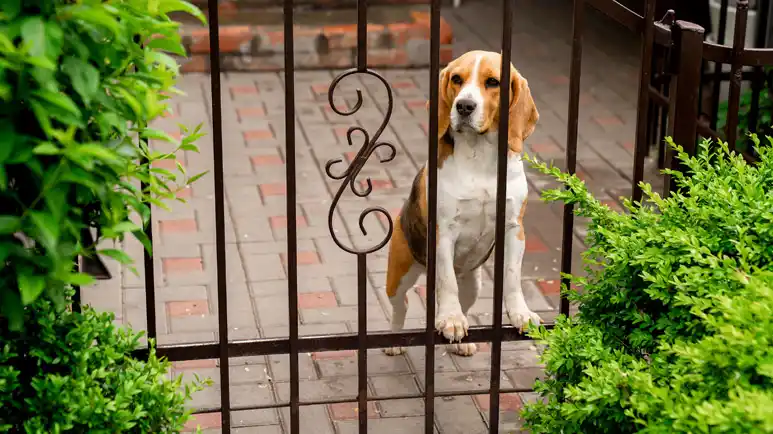Often Leads to Extreme Aggression — Do You Make This Mistake?
This dog was performing his duty as he saw it. But it turned tragic. As you'll see, it didn't have to be that way. His owner made a classic mistake that produced and reinforced a bad behavior — one that no dog owner wants. Please avoid this mistake.

STORY AT-A-GLANCE
- A 2-year-old Australian Cattle Dog named Ruger was diagnosed with territorial aggression after biting a man who was walking past his house
- Ruger developed his behavior problem while spending hours each day alone in his backyard, running the fence, and barking and growling at people and dogs on the golf course behind his house
- Territorial aggression differs from fear aggression in that it tends to develop later, and occurs right at the boundary line of the dog’s territory
- Ruger’s treatment involved supervision when outside, trigger avoidance and learning an alternative response when encountering people along his fence line or on walks
- Dog parents shouldn’t use fenced-in yards as dog sitters, because dogs often start cueing on triggers outside the yard, which can lead to extreme displays of territorialism
Editor's Note: This article is a reprint. It was originally published May 11, 2018.
In 2018, there was a case report in a veterinary journal about a dog diagnosed with territorial aggression.1 It's an interesting case that illustrates the crucial role environment plays in a dog's behavior, and how easy it is for pet parents to overlook connections between the two.
Ruger's Behavior History
At the time the case report was published, Ruger was a 2-year-old intact male Australian Cattle Dog who wound up at a veterinary behaviorist's office after biting a man who was walking past the dog's house. The dog bite was severe enough that it ripped the man's jeans and put two shallow punctures and several scrapes on his thigh.
Ruger's owner bought him from a local breeder when he was 10 weeks old. He attended puppy classes at 16 weeks old and did well. When he was about 10 months old, Ruger began growling and barking at people walking past his house, as well as at people he didn't know who came for visits. Over the next year, these behaviors became more pronounced.
Six months before he bit the passerby, Ruger began barking at dogs and certain people when his owner took him out for walks around the neighborhood. Interestingly, he didn't bark at dogs or humans when he visited the homes of friends or relatives, or during veterinary visits.
In addition, he went to the dog park regularly and to doggy daycare a few times a month without incident, and he had no past or current medical problems. At the veterinary clinic, Ruger wagged his tail, was friendly with the staff, happily took treats when offered and responded well to his name and a sit command.
How Ruger's Territorial Aggression Developed
The veterinary behaviorist treating Ruger, Dr. Lore Haug, learned from his owner that the dog spent a lot of time each day alone in his backyard, which was enclosed by a 5-foot-high wrought iron fence and backed up to a golf course. Alone in the yard with time and energy to burn, Ruger developed the habit of running along the fence, barking, and growling at people, dogs and golf carts passing by.
Haug diagnosed Ruger with territorial aggression resulting from extended time outside and reinforced behavior. She notes that certain dog breeds, especially guarding and herding breeds, are more likely to develop excessive territorial aggression than other breeds. In addition, the problem can be exacerbated by insufficient or inappropriate socialization. Haug writes:
"However, behavior — aggressive or otherwise — is always a reaction to some aspect of the dog's environment, rather than an aspect of the dog itself. Genetics and perinatal experiences do affect the likelihood with which some behaviors develop, but appropriate environmental conditions must exist for the behavior to be expressed."2
Haug makes the point that while testosterone may play a role in aggression, many intact male dogs don't have behavior problems. She also notes that a "slowly growing body of research" suggests desexed dogs may actually be at higher risk for certain undesirable behaviors such as anxiety and aggression than intact dogs.
How Territorial Aggression Differs from Fear Aggression
Territorial behavior is entirely normal in dogs, and even the friendliest dog will typically bark in response to the arrival of an unfamiliar human or animal in his "territory." Family dogs tend to view their owner's house and yard as their territory, and this can extend to the space around a vehicle they ride in a lot, as well as their own crate or kennel.
It's easy to spot territorial aggression because it generally occurs right at the boundary line of the dog's turf, and usually first arises around 8 to 10 months of age. This differs from fear aggression, which tends to manifest much earlier. Without appropriate intervention, territorial behavior will escalate over the next one to two years.
In Ruger's case, the problem was all the time he spent outside by himself "practicing" his aggressive territorial reactions. When Ruger ran the fence growling and barking at people, the people disappeared, and his behavior was reinforced. Barriers, such as the fence around the backyard, tend to exaggerate these behaviors.
Another example Haug offers is the intense reaction many dogs have when someone rings the doorbell or knocks on the front door. These dogs are so aroused that if the behavior is allowed to continue, it can ultimately lead to biting. In Ruger's case, he was performing his normal territorial behavior when he bit the passerby. The difference was that he was able to get through the fence.
"There is a higher risk for bite by an escaped dog that spends a lot of time patrolling the perimeter of the property, fence running, and barking at humans and other animals from the home," Haug writes.
Managing and Preventing Territorial Aggression
Haug advised Ruger's owner to allow him outside only while supervised, and to avoid situations in which he was known to behave aggressively toward people or other dogs. Ruger began basic obedience training, and his owner also began training him to perform an alternative behavior when he encountered people along his fence line or on walks.
"When managing any behavior problem," writes Haug, "it is crucial to evaluate the patient's environment and the context in which the problem behavior occurs. Information regarding the animal's environment is often far more important than information about the animal itself …"
Behavior problems in dogs can almost always be traced to their environment, past or present, to include the food they eat, the way they spend their time, the bond they have with their owners, previous training (or lack thereof), training methods and many, many other factors.
Fenced-in Yards Shouldn't Be Used as Dogsitters
Many pet parents specifically choose homes with fenced-in yards — or they fence in an existing yard — so their dog has a place to run around off-leash.
"The problem with that," says veterinarian and animal behaviorist Dr. John Ciribassi, "is that people start using their yards as babysitters. But dogs don't only need physical exercise, they also need emotional exercise as well — mental stimulation."3
As was the case with Ruger, what often happens is the dog starts cueing on triggers outside the yard, which can lead to extreme displays of territorialism. These include barking excessively, rushing the fence and showing signs of hostility toward people or other dogs passing by. Ciribassi's advice is to not allow a fenced yard to substitute for daily leash walks around the neighborhood and ongoing reward-based behavior training.
"Secondly," says Ciribassi, "when your dog's out in your fenced yard, you should be out there with him. Engage in playtime and training exercises, and just be there with him. Dogs are social," Ciribassi reminds us, "and to just stick them out in the yard alone is like taking an infant and sticking him in a playpen while you go out to work."











